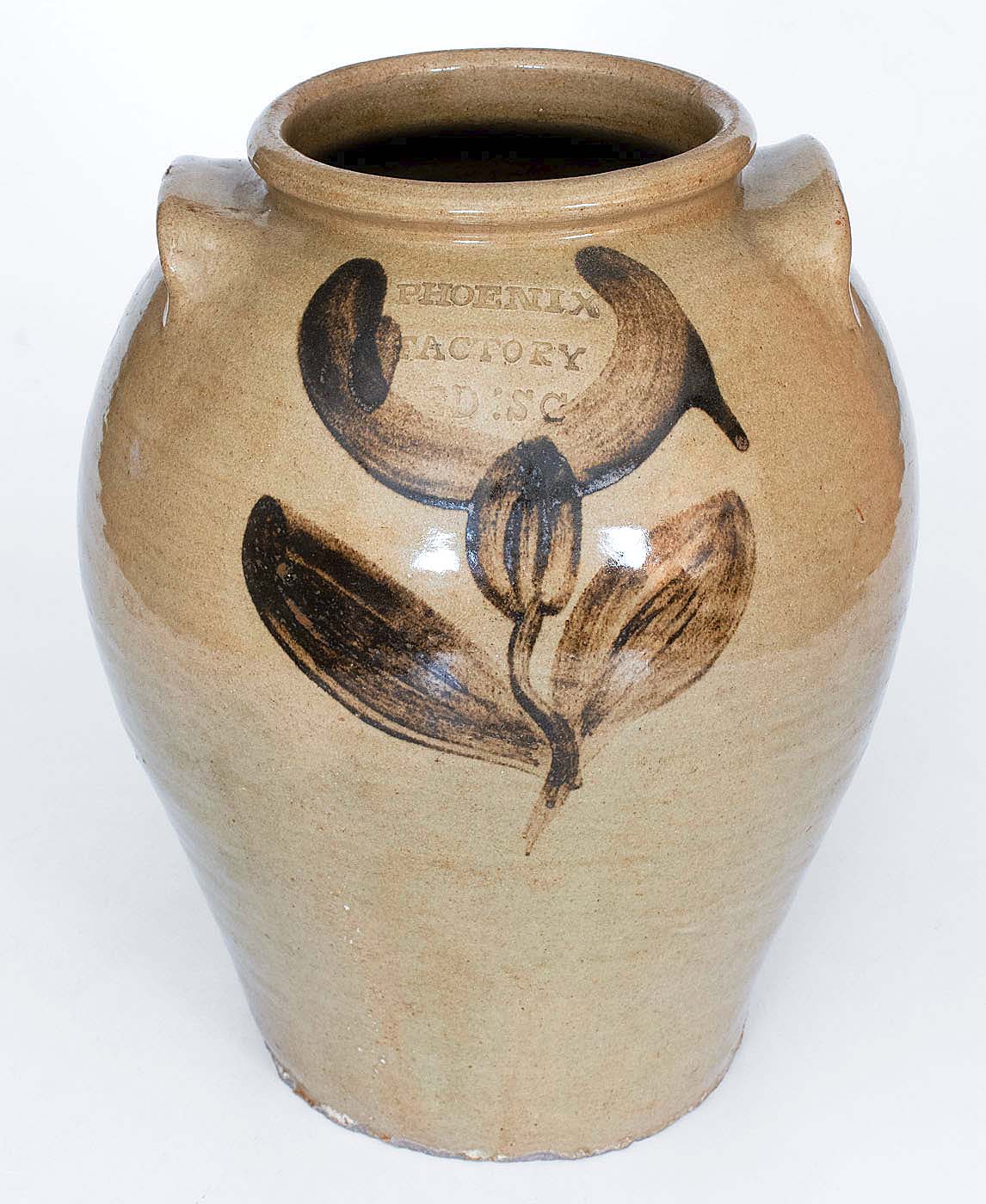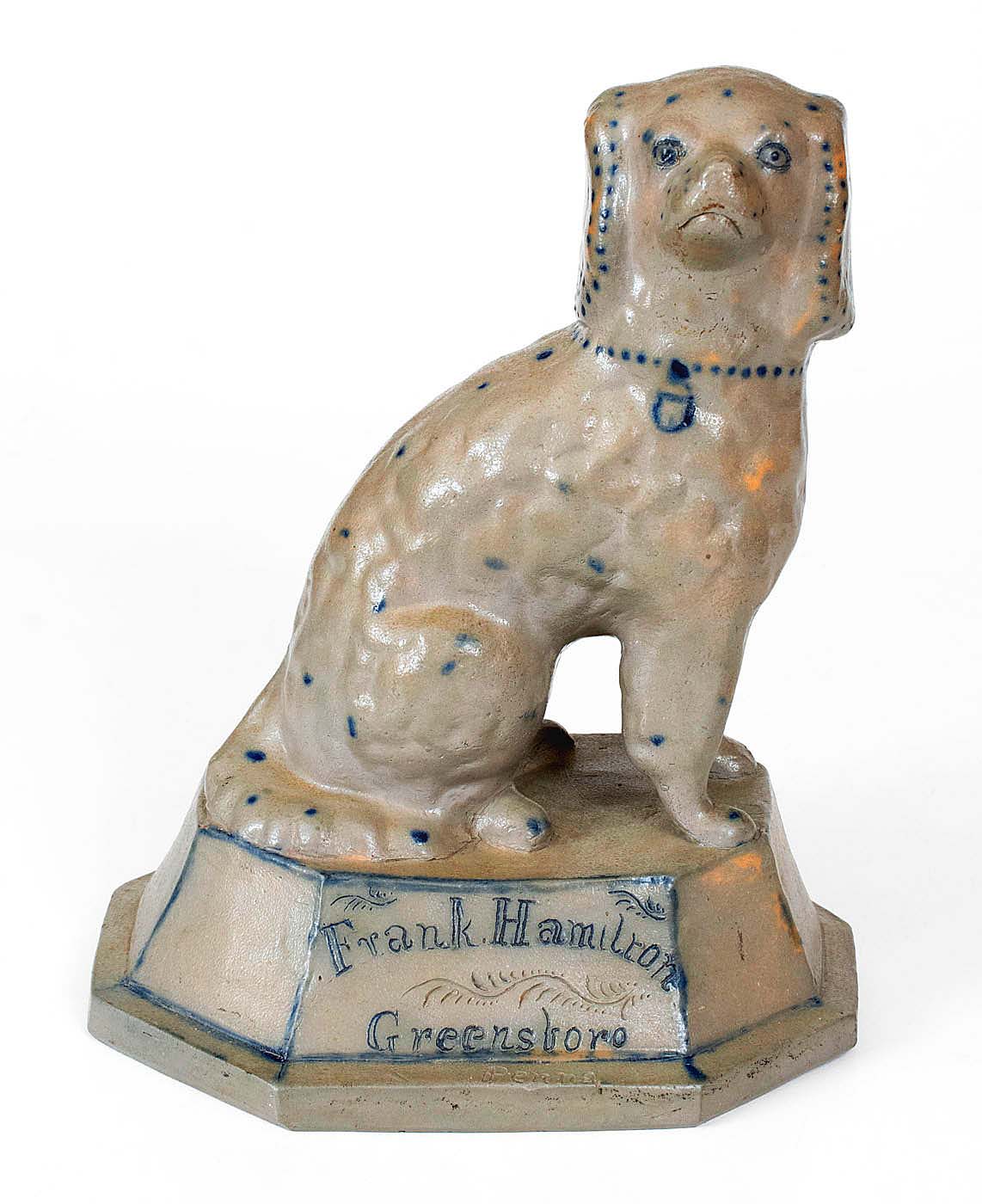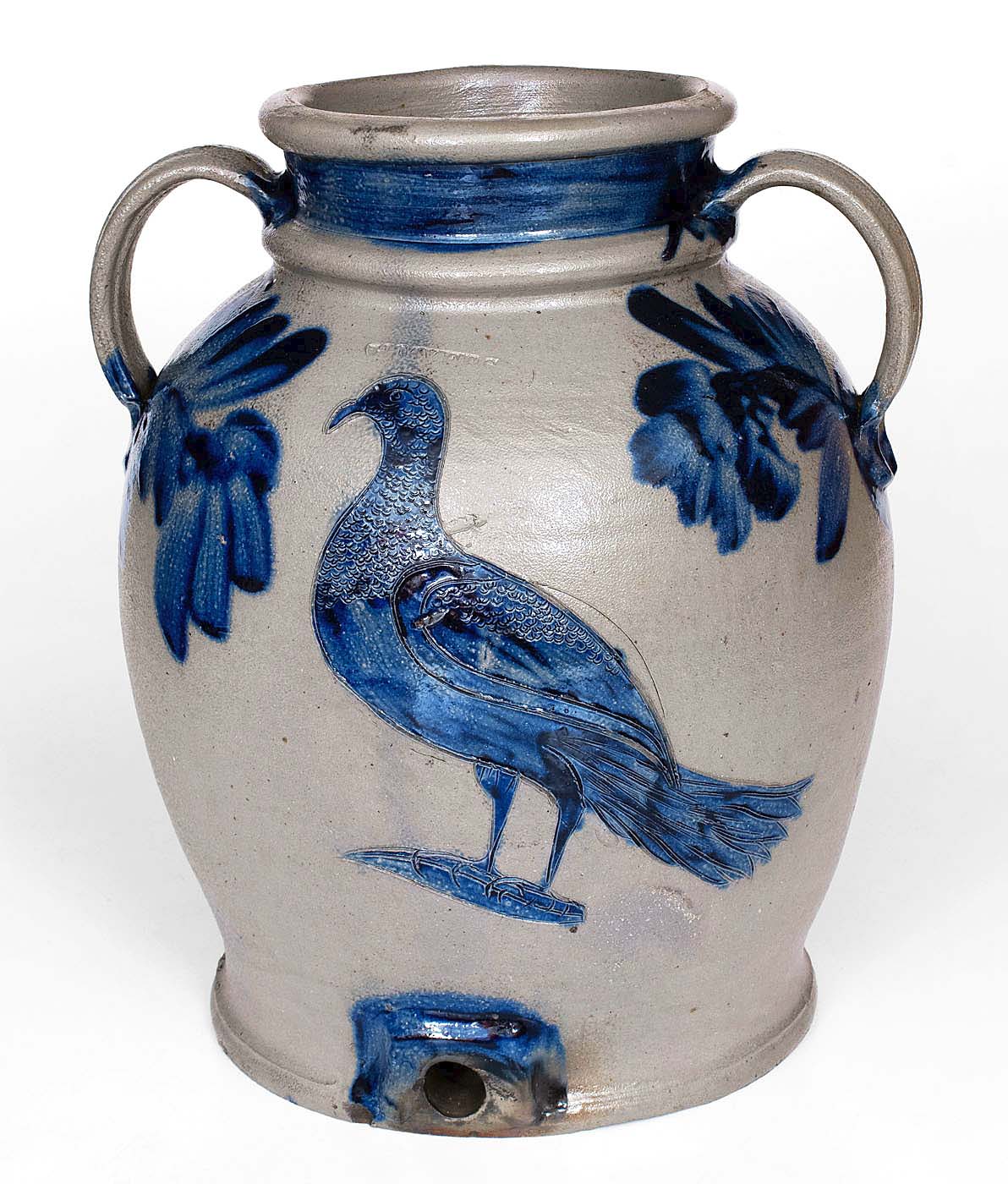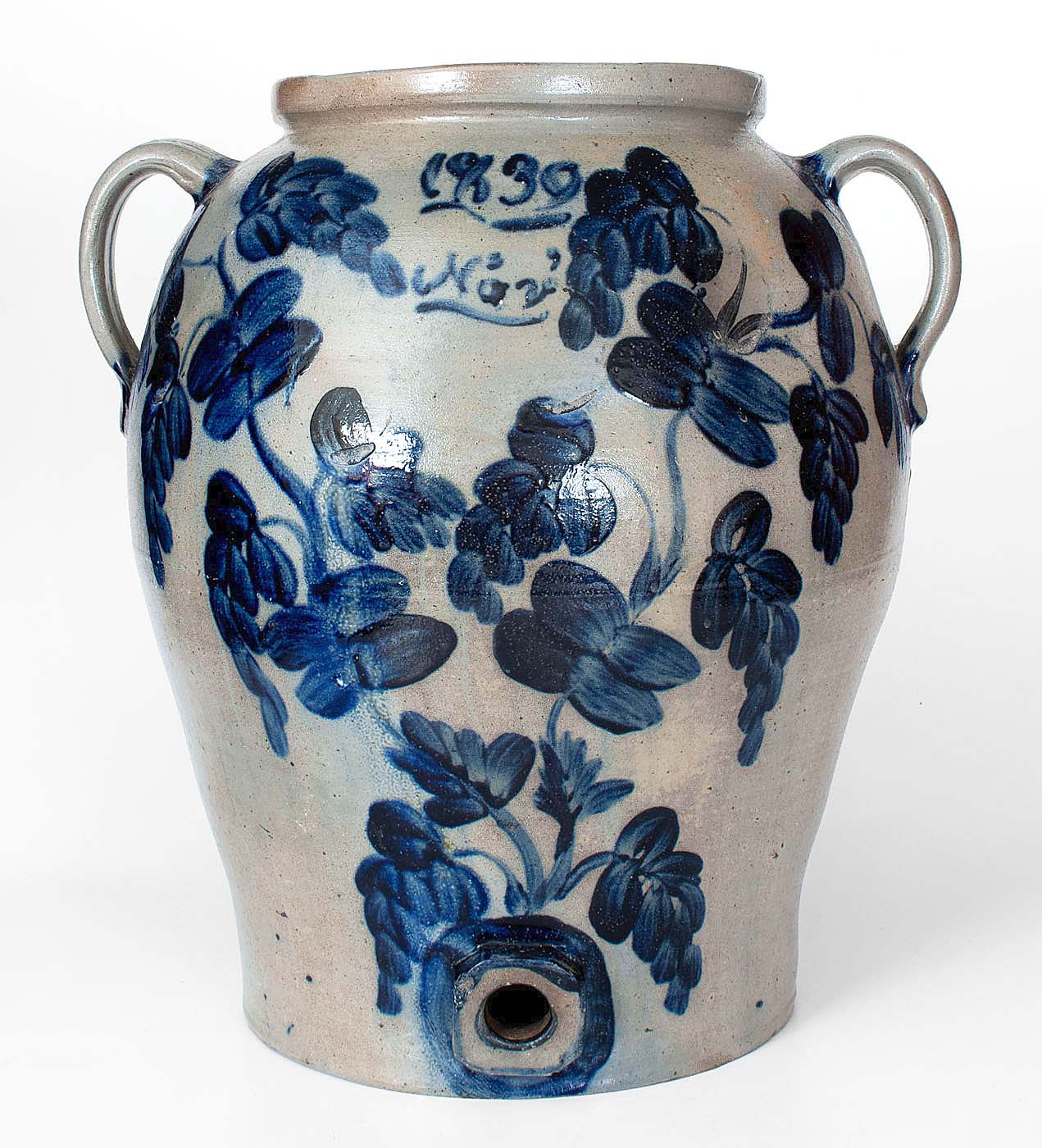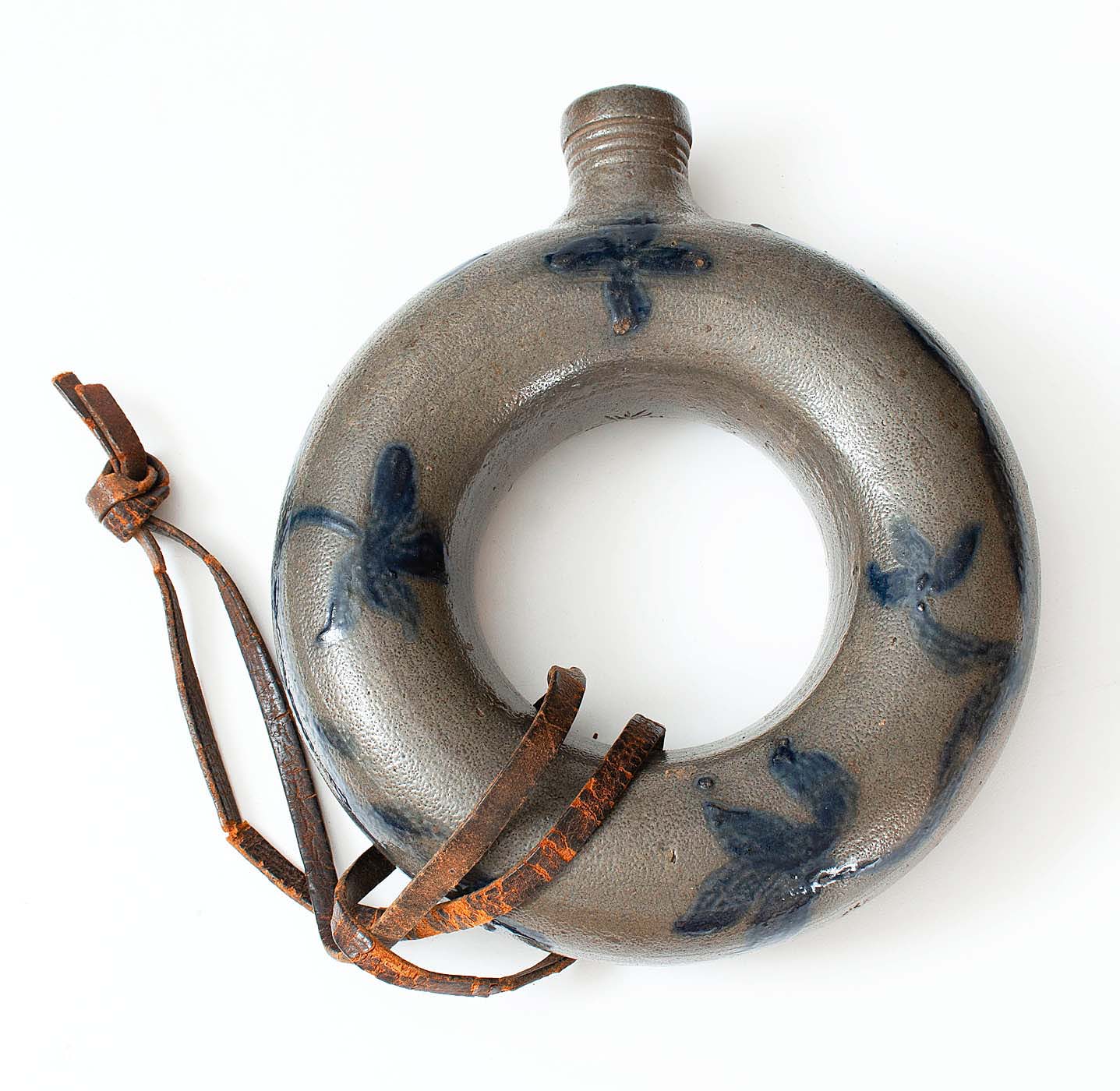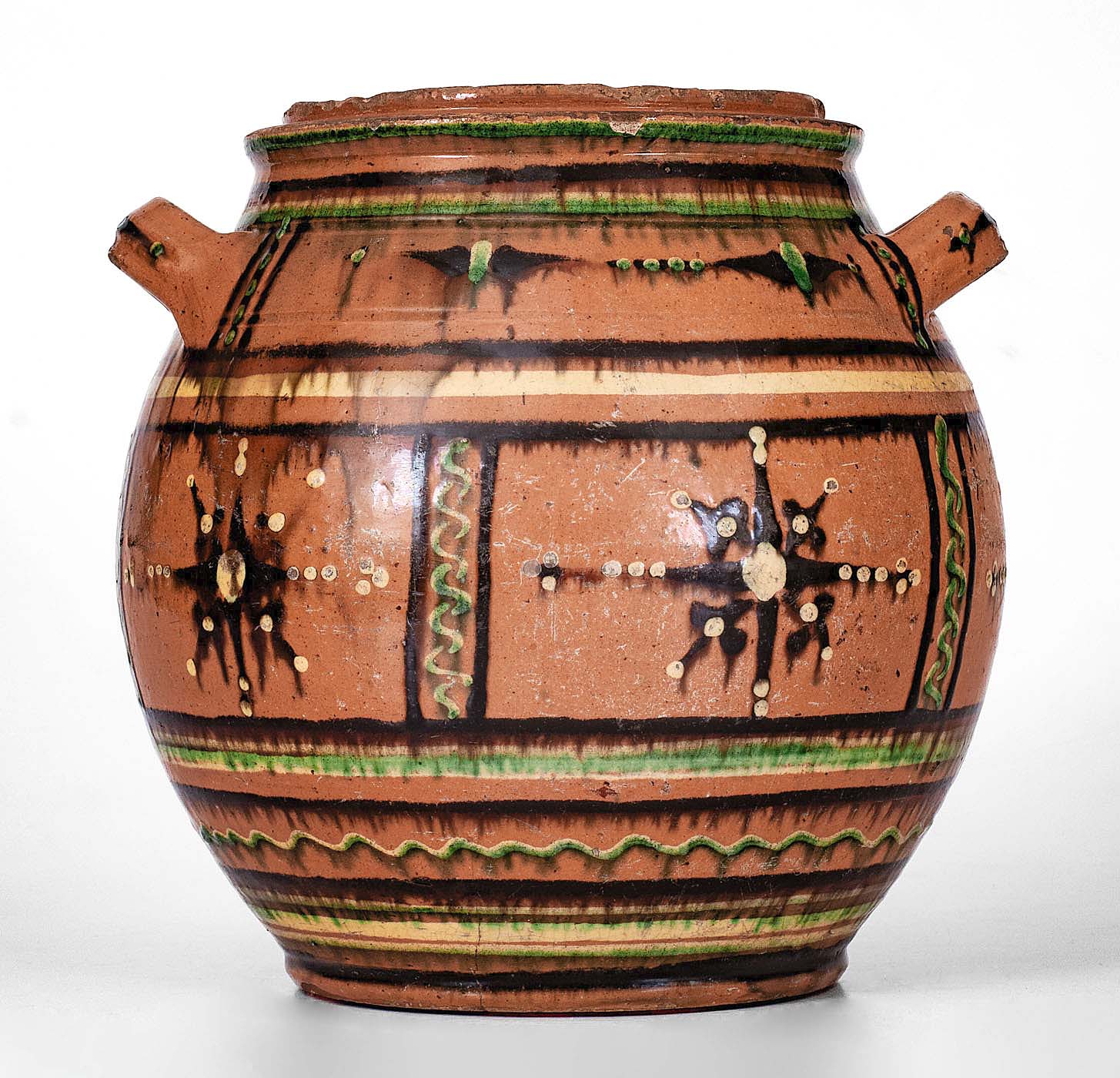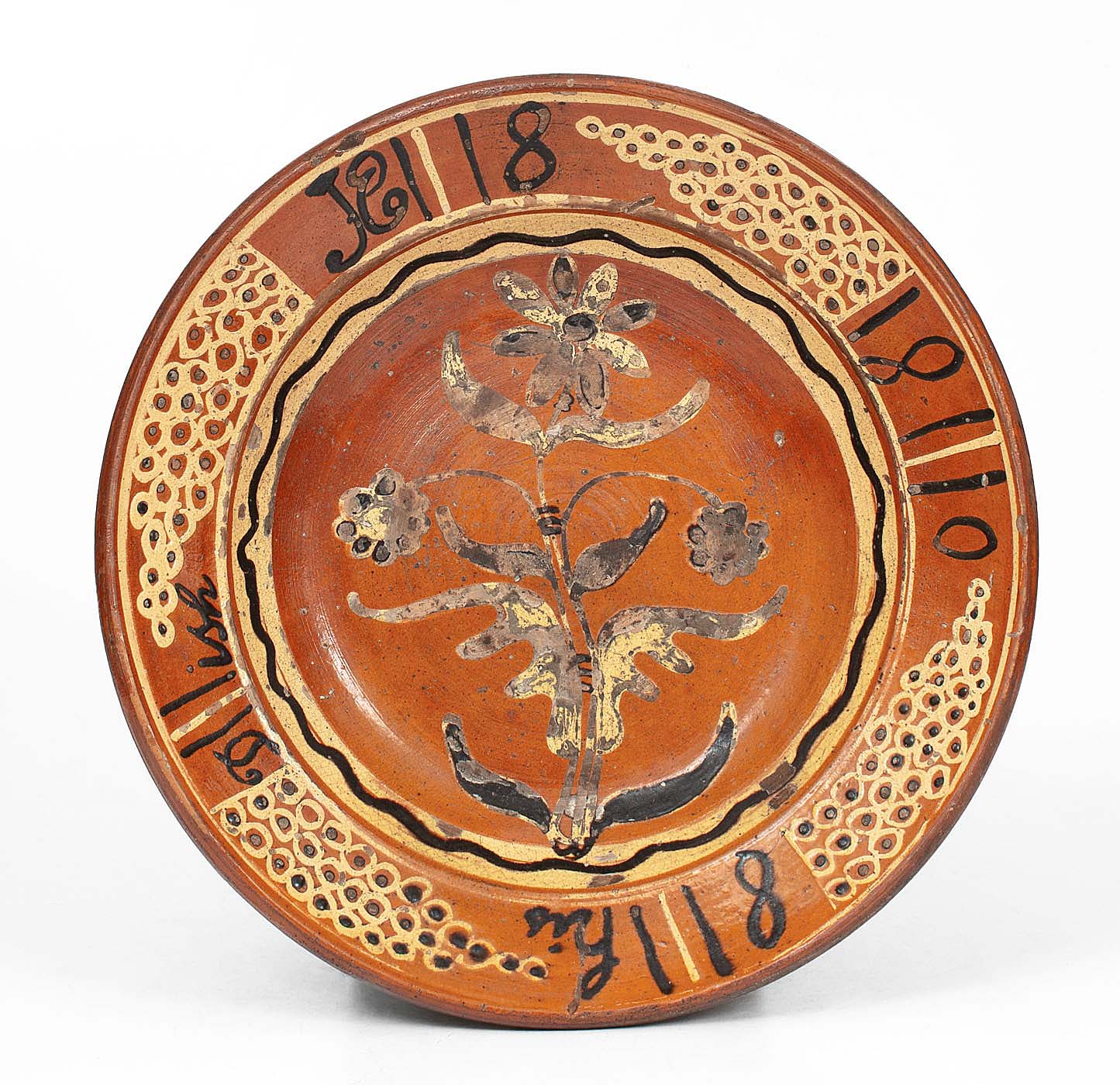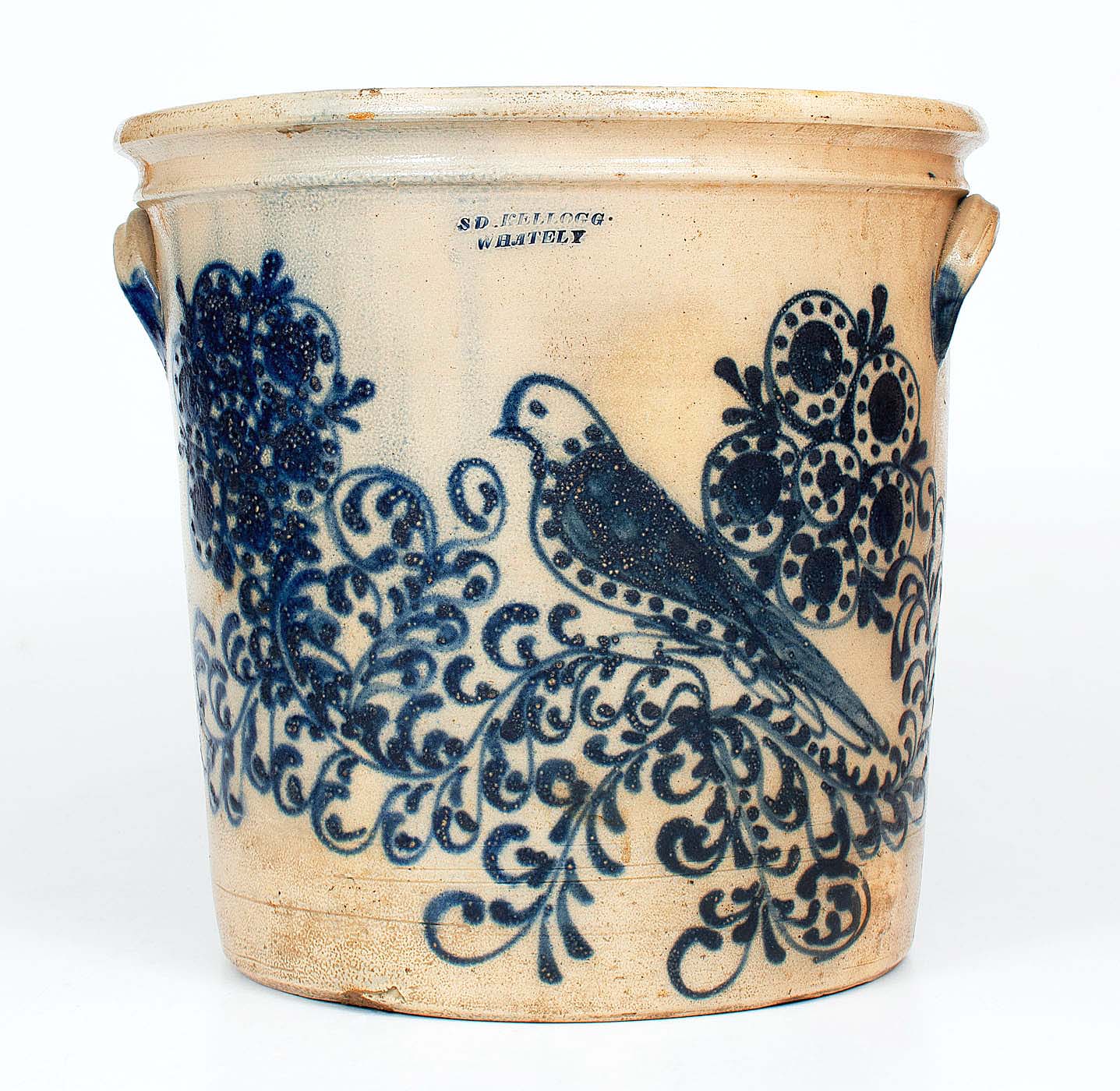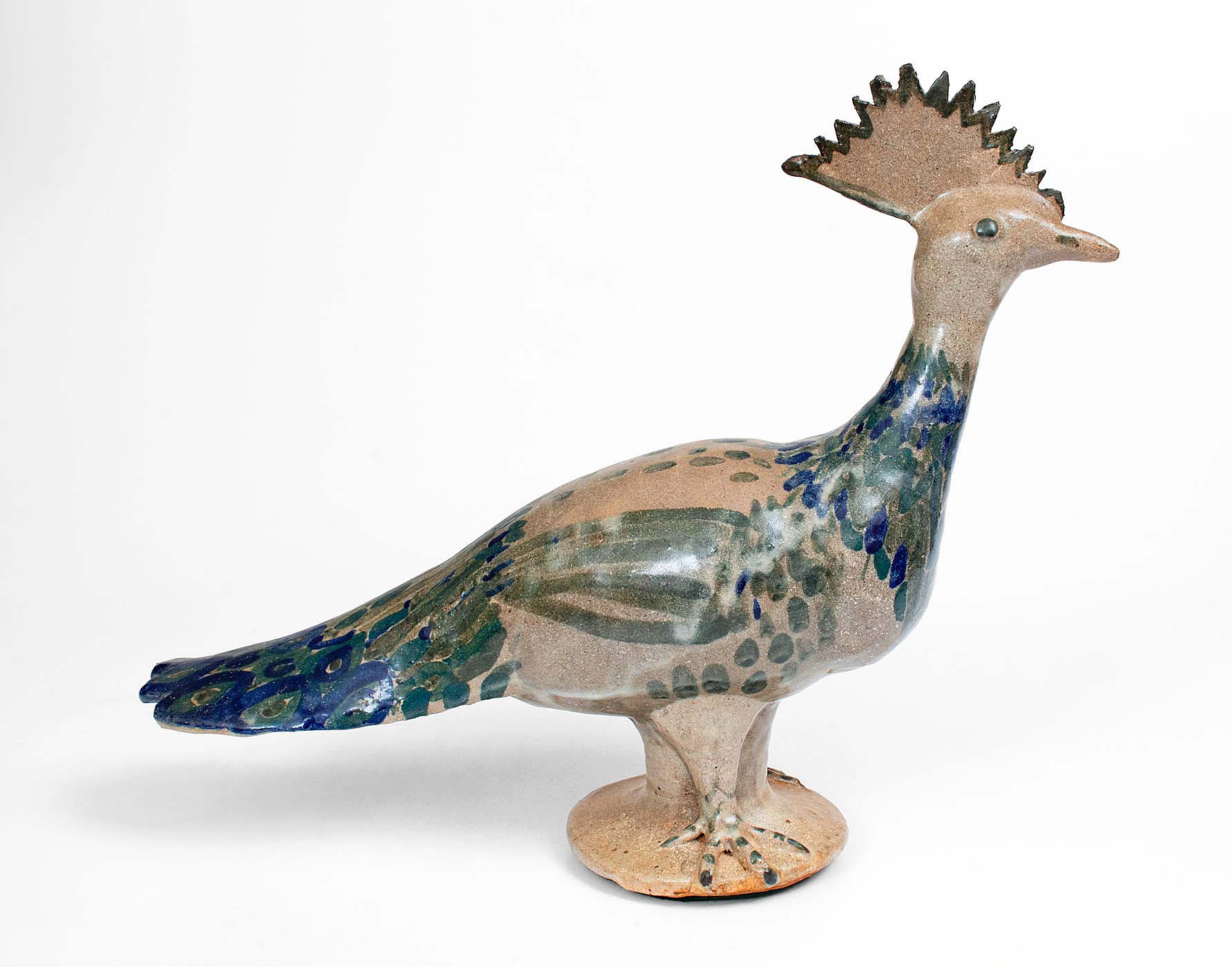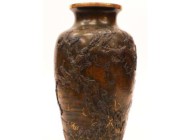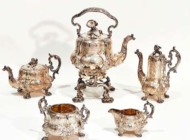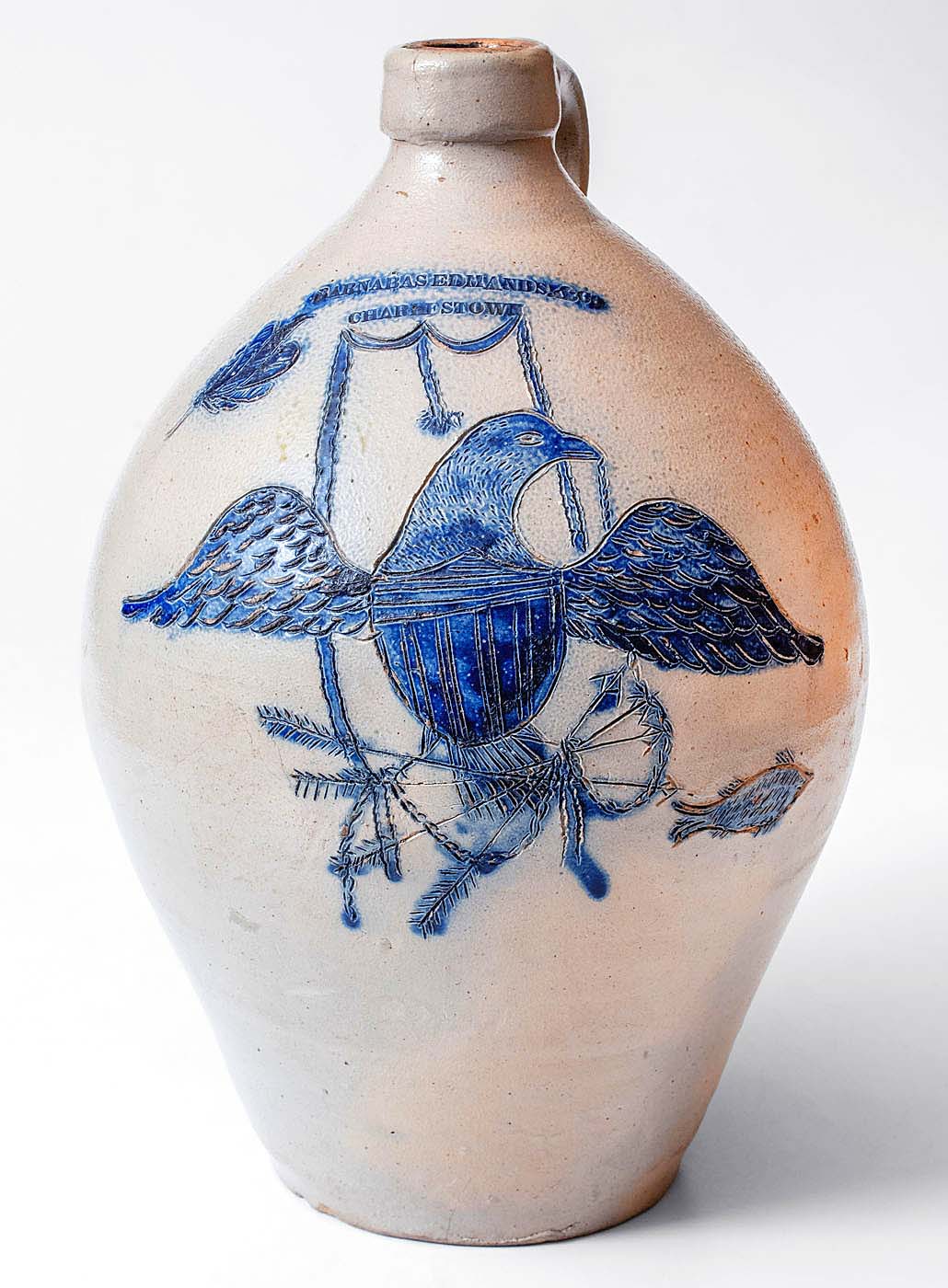
Flying to $180,000 and the top of the sale was this eagle and fish decorated stoneware jug made by Barnabas Edmands & Co., Charlestown, Mass., circa 1830. Provenance and form were among its selling points and it found a new home with clients of ceramics scholar and dealer, Rob Hunter ($50/80,000).
Review by Madelia Hickman Ring; Photos Courtesy Crocker Farm
SPARKS, MD. — If anyone had any questions about the strength of the market for stoneware and redware, they need only look at the results of Crocker Farm’s Spring 2024 auction, which closed in a phone bidding session on April 6 following an online bidding period that began on March 27. Of the 421 lots offered, only one lot did not find a buyer, exceeding a 99 percent sell-through rate and earning a combined $1.75 million, according to Mark Zipp. Regionalism continues to influence buyers, with a significant portion of pieces returning to their areas of manufacture; animals and birds remain perennially favorable decorative elements.
“It was a great auction that really validates where the stoneware and redware markets are right now. We had three six-figure lots, which is very exciting, and we set a couple of records: a new one for Vermont stoneware and tied a record for Massachusetts stoneware. Overall, we’re very happy with the total.”
Exceptional and important pieces are standard fare for Crocker Farm’s sales and several punctuated the top lots in this one. Earning $180,000 and more than doubling its high estimate was a 2-gallon stoneware jug stamped “Barnabas Edmands & Co/Charlestown” that also featured incised cobalt decoration in the form of a wingspread eagle and fish. The auction catalog characterized it both as “among the finest examples of eagle decoration that we have ever offered” and “among the finest examples of Northeastern United States to come to auction in years.” Aesthetics aside, the jug’s provenance was equally significant. Previously owned by ceramics collector and author Georgeanna Greer, it was featured not once but twice on the cover of the first two editions of her 1981 book, American Stonewares: The Art & Craft of Utilitarian Potters. Ceramics scholar and dealer Rob Hunter acquired it on behalf of the William C. and Susan S. Mariner Private Foundation.
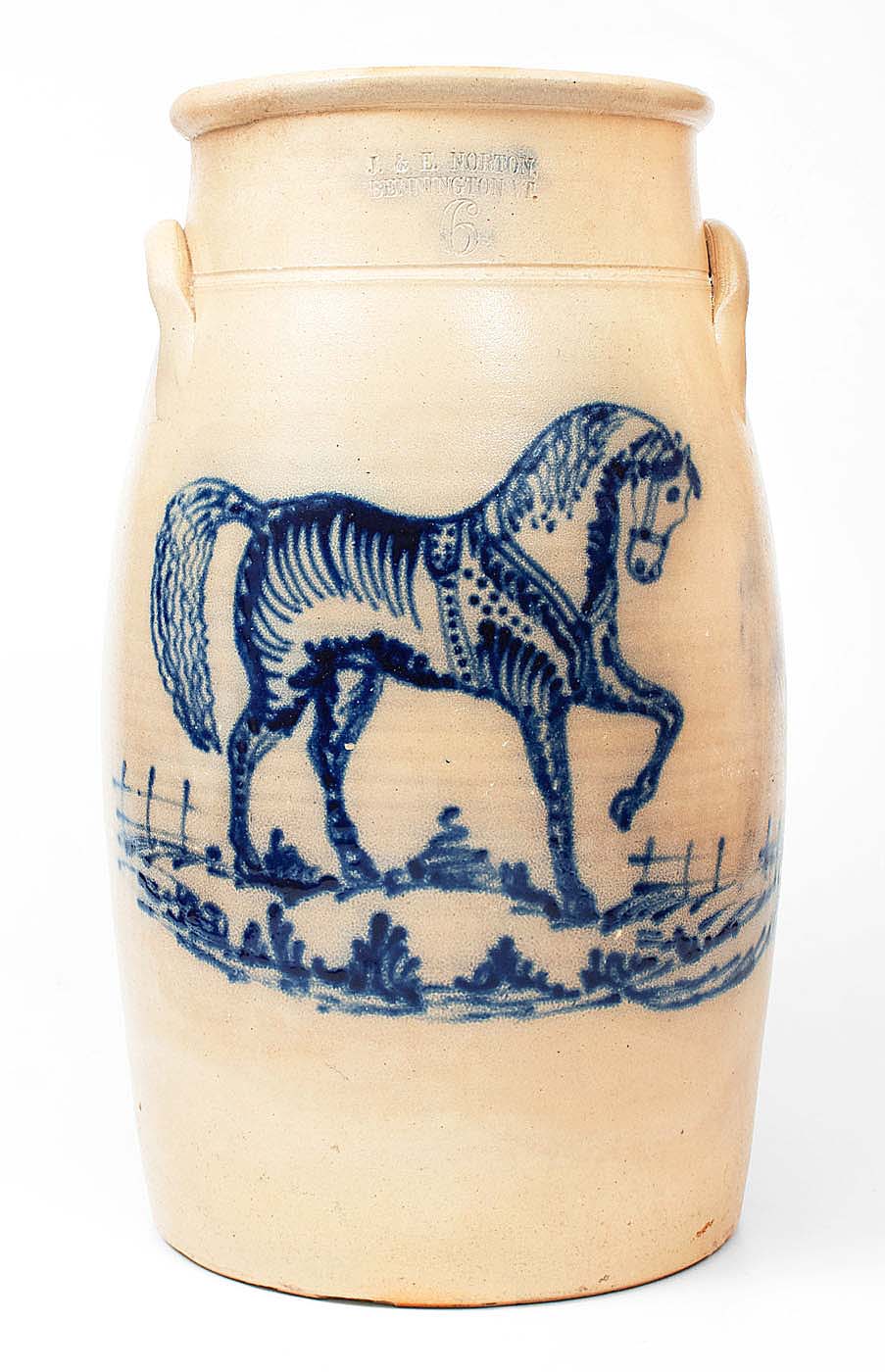
Just two related equine motifs on J&E Norton stoneware have been published, making this 6-gallon churn an exceptionally rare example. The Zipps consider it to be “the finest-decorated example of Norton family stoneware to come to auction in a decade or more”; bidders agreed, taking it from a $25/40,000 estimate to $132,000. A trade buyer bidding on behalf of a client prevailed.
While stoneware by J&E Norton often featured deer, lion and bird motifs, the horse decoration on a 6-gallon stoneware churn was special and helped the piece to ride to $132,000, the sale’s second highest price. The catalog claimed, “the artistry and rarity of the design easily make this churn the finest-decorated example of Norton family stoneware to come to auction in a decade or more.” The horse related to two other examples illustrated in Catherine Zusy’s Norton Stoneware and American Redware: The Bennington Museum Collection (1991).
The animal theme continued on a stoneware water cooler made in Baltimore circa 1821-29 by Henry Remmey, Sr, that featured a grouse that incorporated both incising and brushed cobalt floral elements, a novel decorative technique then coming to the fore. The Zipps had handled the cooler before when it was the cover lot of the firm’s inaugural sale in 2004; at the time, it set an auction record for Baltimore stoneware. Subsequently published in a 2013 Ceramics in America article, it flew to $120,000 and a new home with what Zipp characterized as “a very happy major collector.”
It is always exciting when newly discovered pieces come to market, particularly ones made by potters currently sought-after by both museums and private collectors. Perhaps no other potter is more sought after today than David “Dave” Drake, the enslaved semi-literate potter of Edgefield District, S.C. The first lot of the sale was a six-gallon alkaline glazed stoneware jar with an incised owl motif that was attributed to him, working in either the Pottersville or Lewis Miles Stony Bluff Manufactory. Drake did not sign this vessel with his name but the manner in which he wrote “Eagle toed owl” was characteristic of his hand, as was refined potting, light-colored glaze and small sized penmanship.
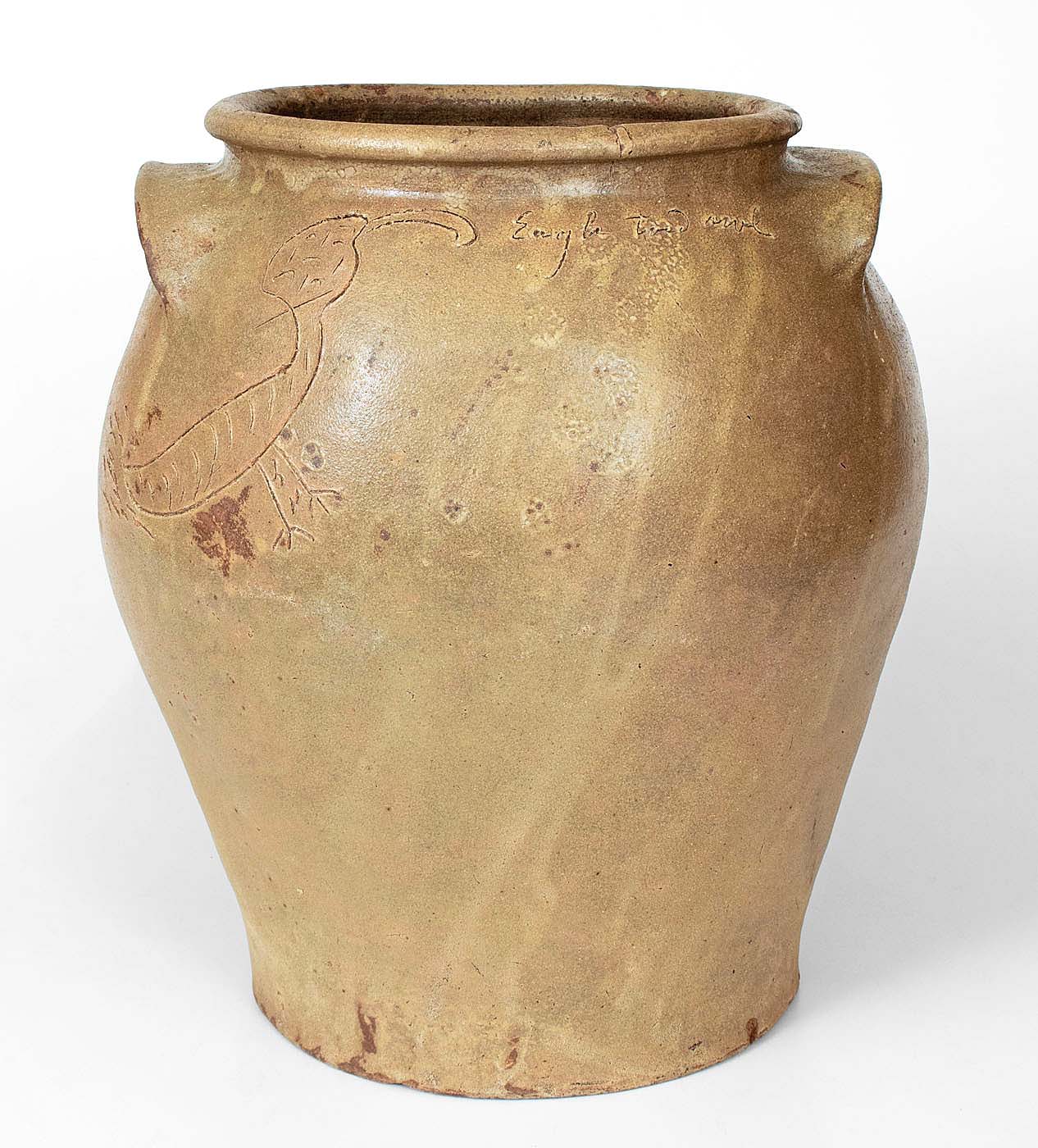
Crocker Farm’s cataloging decreed this jar to be “perhaps the greatest discovery in Drake’s work to come to light in the last decade or more, presenting the man as a three-fold artist: potter, poet, and, in this case, illustrator.” Standing 14¾ inches tall, and featuring an incised owl as its decorative element, the circa 1830-40 6-gallon alkaline glazed stoneware jar earned $72,000 from a private collector ($75/125,000).
“That was a very special piece; it’s one of the few Dave Drake pieces with an incised image,” noted Zipp. He thought the lack of Drake’s signature may have deterred some buyers. It sold to a private collector for $72,000, just below estimate.
Another Edgefield District piece, one stamped “Phoenix Factory ED: SC,” was made during the short-lived partnership of Collin Rhodes and Robert Mathis. It was decorated by its lead potter, Thomas Chandler, circa 1840, and was a recent discovery that earned $39,000. The Phoenix Factory mark is one Crocker Farm considers to be the rarest and most prized of Edgefield’s marks and the first to come to auction market in more than a decade.
Animal figures in three dimensions may not have been quite as plentiful as their two-dimensional counterparts, but a few in the sale achieved strong results. A copper-glazed Moravian turtle-form bottle, made in the first half of the Nineteenth Century in Salem, N.C., exceeded its estimate to bring a strong and steady $48,000. Believed to be the only example known of the smaller size — 6½ inches in length compared to larger 7¼-inch versions — and style, it was published in Moravian Press-Molded Earthenware by Johanna Brown, which appeared in the 2009 edition of Ceramics in America. Brown, the newly appointed curator of Moravian decorative arts at Old Salem Museums & Gardens, confirmed the museum had purchased it for its Old Salem collection, where it will go on view in the Dianne H. Furr Moravian Decorative Arts Gallery.
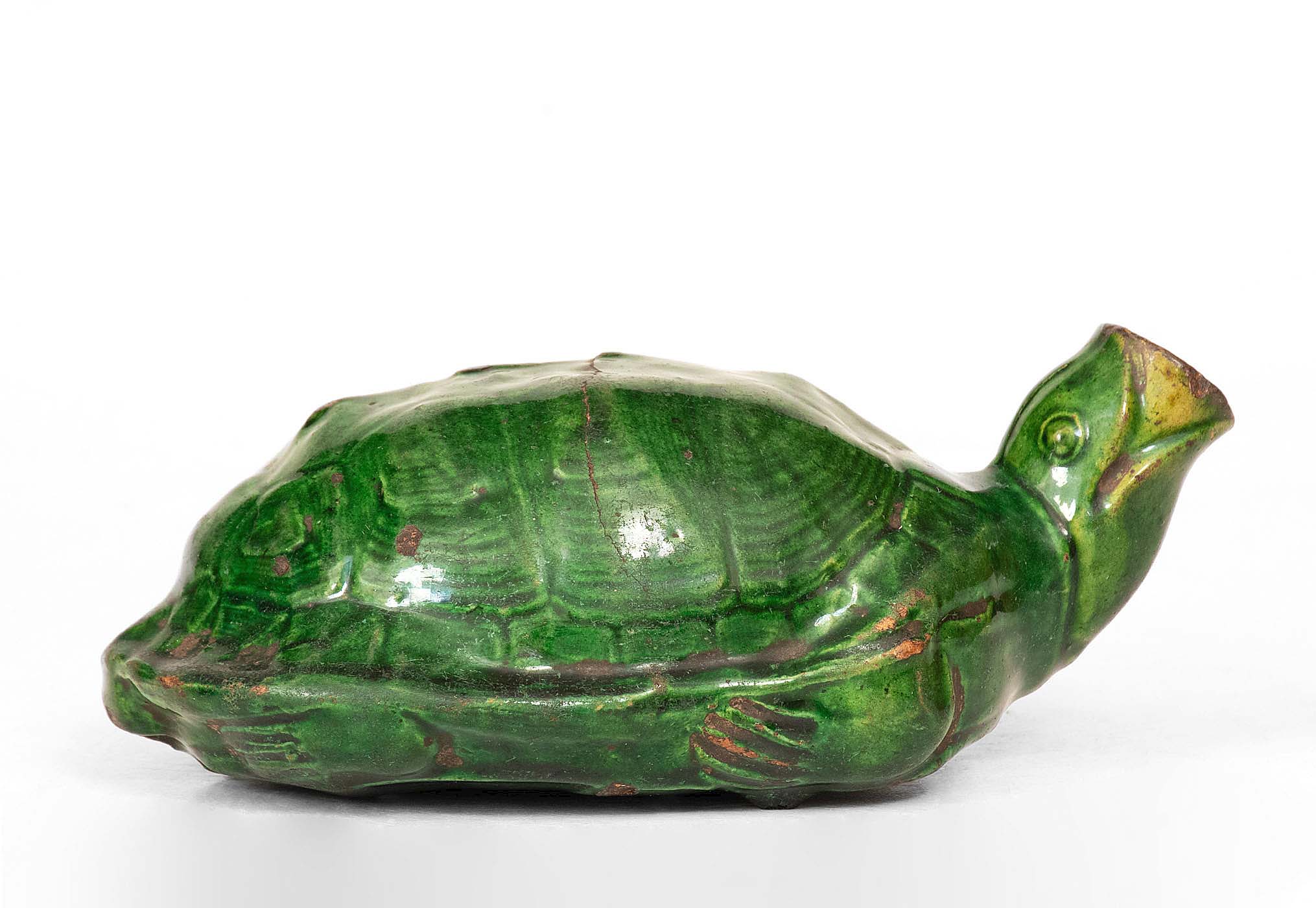
Old Salem Museums & Gardens acquired this Moravian turtle-form copper-glazed redware bottle for $48,000 ($20/30,000).
A seated stoneware spaniel for Frank Hamilton of Greensboro, Penn., and signed “Jas. A. Atchison” fetched a cool $26,400. The 10¼-inch-tall dog was from a small group of signed spaniels and had great visual appeal. Combining that with rarity of form and the significance of connections to two of the most important figures in the Western Pennsylvania pottery tradition, the dog was a favorite among bidders. A collector of Western Pennsylvania decorative arts gave it a new home.
Rounding out animal highlights, a peacock with tri-color slip decoration, made by Arie Meaders in Cleveland, Ga., circa 1956-69 was noted for its imposing size, unusual form and remarkable profuse slip decoration. The 13¾-inch-tall figure was described as “among Arie Meaders’ finest birds known.” Bidders concurred, chasing it from a $5/8,000 estimate to $42,000, a price Zipp said was a record for an Arie Meaders sculpture.
An Arie Meaders’ face jug from the same period that is one of only 25 known face jugs by the maker — and featured on the cover of The Folk Pottery of Cheever, Arie, and Lanier Meaders: A Pictorial Legacy by Michael A. Crocker and W. Newton Crouch Jr, (Giffin, Ga., 1994) — overflowed its $20/30,000 estimate to bring $32,400.
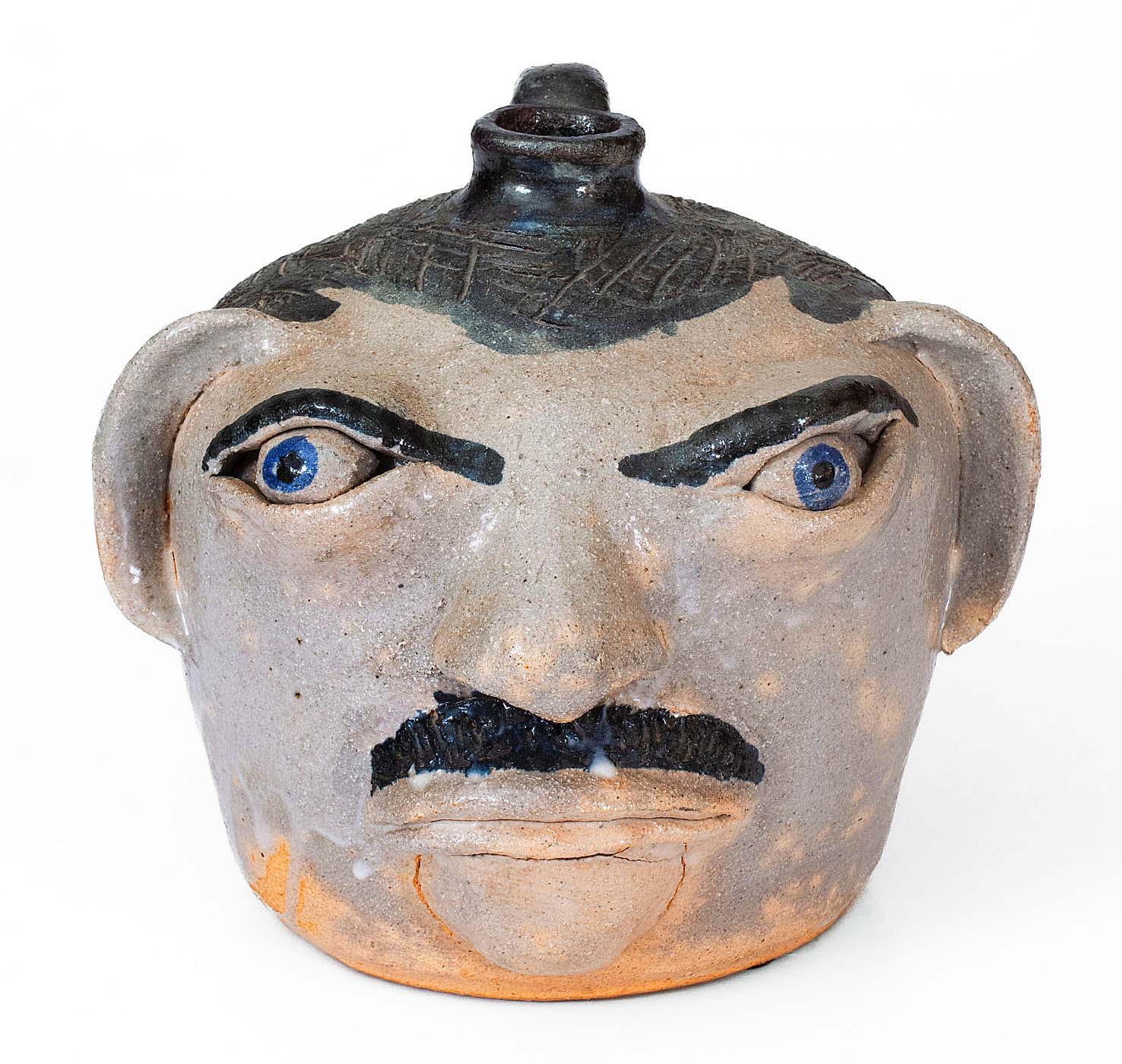
This glazed stoneware face jug with black and blue slip decoration, made by Arie Meaders at the Cheever Meaders Pottery, Cleveland, Ga., stood just 6¾ inches tall but is considered a significant example from just 25 known related examples. A Southern collector won it for $32,400 ($20/30,000).
Alamance County sugar jars are a highly desirable form, and, in its November 10, 2023, sale, the house set a new world auction record for an Alamance County, N.C., sugar jar at $132,000. The earlier sale prompted the consignment of another sugar jar, dated to 1790-1820, and one that was noteworthy for its large size (one of just two documented similarly sized examples) and equally rare form, also with only one other comparable example. Considered a masterpiece of its form, it was included in the traveling exhibition, “Exhibited: Art in Clay: Masterworks of North Carolina Earthenware,” which was on view at MESDA, Colonial Williamsburg and the Milwaukee Museum of Art from 2010 to 2013. When Crocker Farm sold the jar in its October 28, 2017 sale, it achieved $59,000; in this sale, it brought $45,000 from a North Carolina collector.
Ring flasks are not a rare form, per se, but cobalt-decorated ones made in the United States are, with examples from Virginia all but non-existent. One with incised Federal eagle and brushed cobalt decoration from Loudon County, Va., inscribed “George Duncan,” was another rarity as one of just two pieces signed by the maker and featured what was believed to be its original leather strap. Declared “among the most significant discoveries in Southern cobalt-decorated stoneware in the past few decades,” it saw interest that took it to $39,000.
Crocker Farm’s Twentieth Anniversary auction will take place July 17-26.
Prices quoted include the buyer’s premium as reported by the auction house. For information, www.crockerfarm.com or 410-472-2016.

